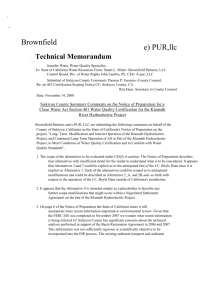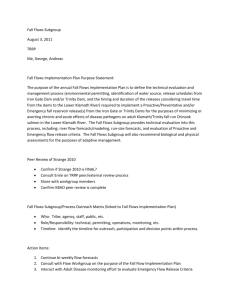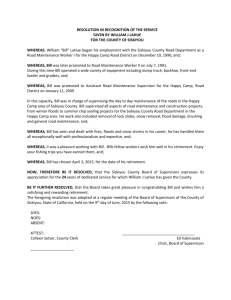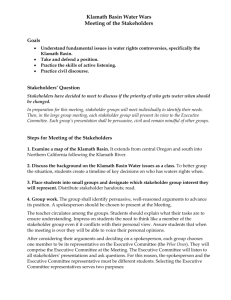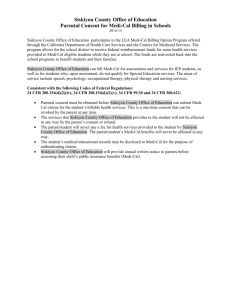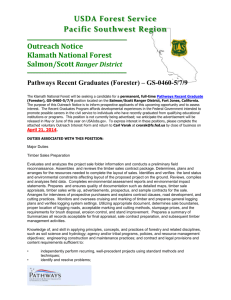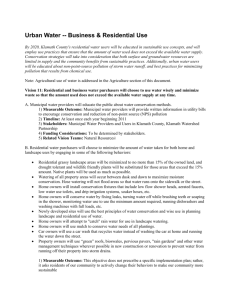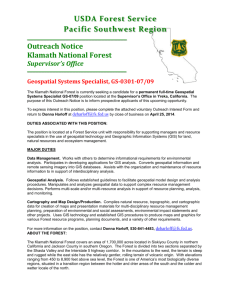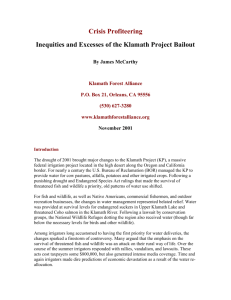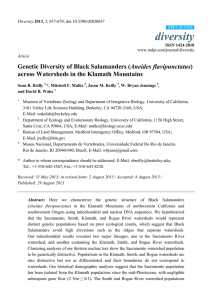Benefits and Costs of Dam Removal To the People of Siskiyou County
advertisement
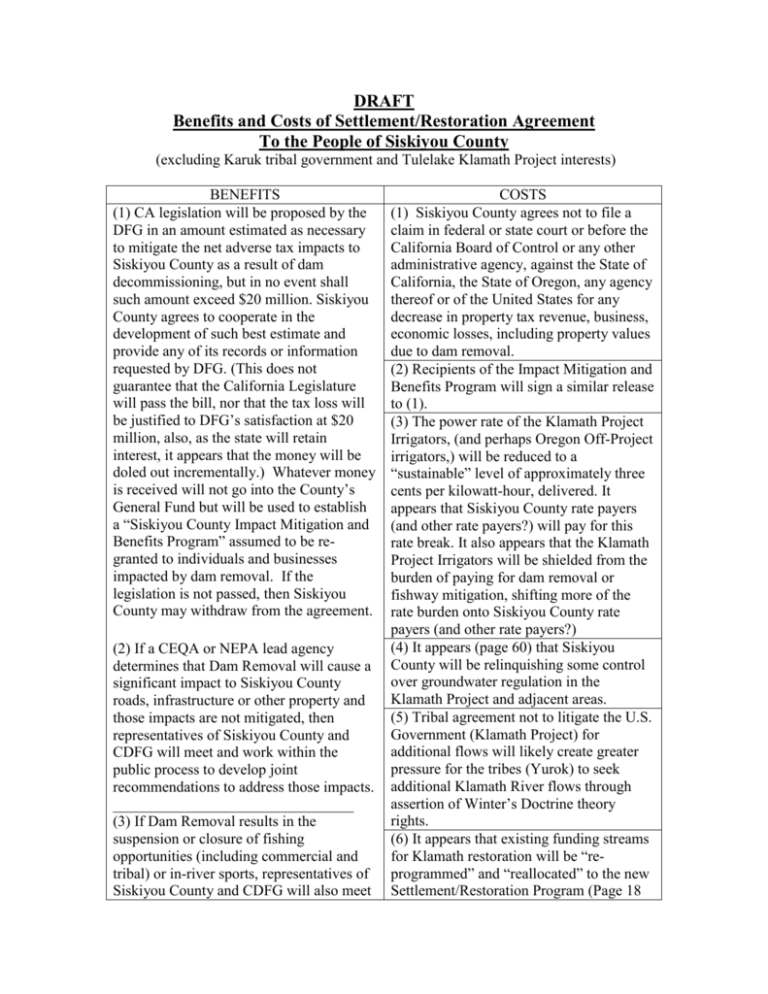
DRAFT Benefits and Costs of Settlement/Restoration Agreement To the People of Siskiyou County (excluding Karuk tribal government and Tulelake Klamath Project interests) BENEFITS (1) CA legislation will be proposed by the DFG in an amount estimated as necessary to mitigate the net adverse tax impacts to Siskiyou County as a result of dam decommissioning, but in no event shall such amount exceed $20 million. Siskiyou County agrees to cooperate in the development of such best estimate and provide any of its records or information requested by DFG. (This does not guarantee that the California Legislature will pass the bill, nor that the tax loss will be justified to DFG’s satisfaction at $20 million, also, as the state will retain interest, it appears that the money will be doled out incrementally.) Whatever money is received will not go into the County’s General Fund but will be used to establish a “Siskiyou County Impact Mitigation and Benefits Program” assumed to be regranted to individuals and businesses impacted by dam removal. If the legislation is not passed, then Siskiyou County may withdraw from the agreement. (2) If a CEQA or NEPA lead agency determines that Dam Removal will cause a significant impact to Siskiyou County roads, infrastructure or other property and those impacts are not mitigated, then representatives of Siskiyou County and CDFG will meet and work within the public process to develop joint recommendations to address those impacts. ________________________________ (3) If Dam Removal results in the suspension or closure of fishing opportunities (including commercial and tribal) or in-river sports, representatives of Siskiyou County and CDFG will also meet COSTS (1) Siskiyou County agrees not to file a claim in federal or state court or before the California Board of Control or any other administrative agency, against the State of California, the State of Oregon, any agency thereof or of the United States for any decrease in property tax revenue, business, economic losses, including property values due to dam removal. (2) Recipients of the Impact Mitigation and Benefits Program will sign a similar release to (1). (3) The power rate of the Klamath Project Irrigators, (and perhaps Oregon Off-Project irrigators,) will be reduced to a “sustainable” level of approximately three cents per kilowatt-hour, delivered. It appears that Siskiyou County rate payers (and other rate payers?) will pay for this rate break. It also appears that the Klamath Project Irrigators will be shielded from the burden of paying for dam removal or fishway mitigation, shifting more of the rate burden onto Siskiyou County rate payers (and other rate payers?) (4) It appears (page 60) that Siskiyou County will be relinquishing some control over groundwater regulation in the Klamath Project and adjacent areas. (5) Tribal agreement not to litigate the U.S. Government (Klamath Project) for additional flows will likely create greater pressure for the tribes (Yurok) to seek additional Klamath River flows through assertion of Winter’s Doctrine theory rights. (6) It appears that existing funding streams for Klamath restoration will be “reprogrammed” and “reallocated” to the new Settlement/Restoration Program (Page 18 to develop recommendations to address those impacts. item 4.11) (7) It appears that the “Fish Managers” (U.S. Fish and Wildlife Service, NOAA Fisheries and the Tribes) shall write Phase I of a Klamath River Fisheries Restoration Plan. This will establish restoration priorities and criteria for selection of projects. Representatives from the Counties, RCDs, landowners and industry will be excluded from decision-making. (page 32-33) (8) It appears that the tribes shall be “priority recipients of federal grants and funds for Fisheries Program” over the Scott, Shasta, Salmon and Klamath River landowners. (Page 138, item 34.3) (9) The Agreement “Governance Framework” structure will include one representative each from the federal agencies; each of the two states; each of the three counties - Klamath, Siskiyou and Humboldt Counties; each of the Klamath Yurok, Karuk and Hoopa tribal governments; The On-Project water users; the Off-Project (Oregon) water users; commercial fishing industry; and conservation/restoration organization. It appears that there is no representation for the Scott and Shasta RCDs, recognized watershed councils or farming and ranching industries. C.3 (10) It appears that the Chartered Klamath Basin Coordinating Council (KBCC) will also serve as a FACA committee making recommendations to federal agencies as sort of a basin-wide steering committee. Scott and Shasta Interests and industry are not included on the FACA. However, there appears to be a disproportionate representation on the FACA of groups with an economic interest in forcing/coercing others to transfer wealth and act against their own interests. (11) It appears, (by definition of the “Klamath Basin,”) that the Scott and Shasta Valleys, without representation, would be subject to the Drought Plan. This appears to have implications to the Scott, Shasta, Seiad and other long-standing water use right adjudications under the jurisdiction of the Superior Court of Siskiyou County. (Page 92-95) (12) It appears, (by definition of the “Klamath Basin”,) that the mid Klamath (including Scott and Shasta Valleys) would be subject to the Climate Change Plan and the resultant “management of water resources. This appears to have implications to the Scott, Shasta, Seiad and other long-standing water use right adjudications under the jurisdiction of the Superior Court of Siskiyou County. (Pg. 97-98) (13) It appears that the reintroduction plans will include the entire Klamath River system and will include management of Chinook, coho, steelhead, Pacific lamprey where the species was historically present. This would appear to include areas such as above Dwinnell dam. No provisions are made for ESA Safe Harbor or other regulatory considerations for coho reintroduction in this area. (Page 36-37) (14) The Agreement appears to establish an interim fishery for the Klamath tribe in the area between I-5 and Iron Gate on the Klamath to begin after quotas are met at the hatchery. (If it still functions.) It is not clear what special rights the tribe will have as to place/season/limits/methods and how this will affect competing in-river sports fishery and the resorts dependent upon them. (Page 139) (15) The Klamath Basin Coordinating Council (KBCC) will link and coordinate sub-basin watershed organizations and resource conservation districts. This appears to create a regional structure where plans and decisions of the KBCC can be directly implemented. This would appear to circumvent the jurisdiction and authority of the elected County government over land use and natural resource use planning on private lands and remove governmental protections and accountability for private property rights. (16) It is unclear in Appendix C.6-7 whether the TAT (Technical Advisory Team) will make recommendations to the KBCC and “Lead Parties” on “management of resources” and “water operations in the Shasta and Scott Valleys that affect lower Klamath River mainstem ecosystems in the period before, during and after dam removal. (17) It appears that Siskiyou County will incur new travel expense to participate in the KBCC and TAT.
